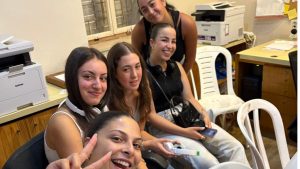Lessons of the Shoah
Published April 30, 2009
More than 200 people turned out at the Washington University School of Medicine last Thursday, April 24 to hear Dr. Gustav Schonfeld tell the harrowing story of being with his family as they were transferred from one death camp to another, including Auschwitz and Dachau, before their liberation in 1945.
Schonfeld, who is a renowned researcher on heart disease prevention and cholesterol at the School of Medicine, gave the university’s annual lecture on the relationship between medicine and the Shoah, which has been part of the Grand Rounds Series at the school for the past 20 years. He said Yom HaShoah is a “tripartite” commemoration. “First, we commemorate the martyrs who died at the hands of the Nazis; second we celebrate the fact that Adolf Hitler and his Nazi thugs are dead; and third, we celebrate the fact that we are alive.”
Last year, Schonfeld published Absence of Closure, a book detailing the experiences of his family in a part of Czechoslovakia that became part of pro-Nazi Hungary with the 1938 Munich Pact, designed to appease Hitler by dismembering the Czech state. He spoke about the role of German doctors in the war crimes and the experiences of his immediate and extended family during the Holocaust years.
“The Nazis viewed themselves as the Master Race,” Schonfeld said, “and they abused medical science to advance those views.”
The Nazis sterilized Germans deemed unfit. They wanted to use eugenic means to assure that the Germans would be physically strong. The Nazis also killed the physically and mentally ill, so that they would not be a ‘burden’ on the state. They also forbade miscegenation, the marriage between so-called German ‘Aryans’ to Jews, Slavs and others they considered inferior or impure.
“They also set about the absolute eradication of the Jews, whom they considered to be a danger to the health and racial purity of Germany,” he said.
Turning to the specific role played by German medicine and physicians in the Holocaust, Schonfeld pointed out that half of German physicians voluntarily joined the Nazi Party by 1936. “Why? They felt it would advance their careers, and they liked the fact that German Jewish professors and physicians were fired from their positions, opening up jobs for the so-called ‘real’ Germans,” he said.
German physicians participated in all aspects of the Nazi program, helping develop the means to efficiently kill large numbers of people. At the camps, doctors selected those who would be killed.
Schonfeld called anti-Semitism within medicine an “old story,” and showed slides of the anti-Jewish statements of a bishop going back to 380 CE, which attacked Jewish doctors, and another document issued by Pope Gregory XIII in 1370 forbidding Catholics from going to Jewish physicians.
Turning to his own story and that of his family, Schonfeld said that his father, Alexander Schonfeld was also a medical doctor. He described his relatively happy childhood in the Czech town of Munkacs, despite “periodic civic strife, poverty and anti-Semitic prejudice.”
“Memories of my life before the Second World War are pleasant ones,” Schonfeld said. He showed slides of his parents’ wedding in 1931 and another of his Hebrew school, where he was seated next to his brother.
After the events of 1938 and 1939, when the town of Munkacs switched overnight from Czechoslovakia to become part of Hungary, which was then pro-fascist, the lives of Schonfeld’s family changed radically.
“We were degraded from well-to-do, solid middle-class status to a slavish, fear-filled, beast-like existence in the camps,” he wrote in his book.
Under the pro-Nazi Hungarian regime, a Nuremberg-esque series of laws were passed, which forced Alexander Schonfeld to give up his medical license. Schonfeld said his mother “had the moxy to travel to Budapest and bribe an official to get my father’s license back,” but things would continue to go from bad to worse for the family.
The Jewish population of Munkacs was first sent to work in a brick factory. Jews were forced to wear yellow armbands, and were put into ghettos, where they heard rumors that Polish Jews were being killed across the border. Eventually, Schonfeld and his family were loaded into a cattle car and transported with other Hungarian Jews to the Auschwitz death camp. Schonfeld’s father ran ahead in the line and came back to tell his wife to say that she was a nurse and to let her mother hold their baby.
“Dr. Joseph Mengele…told my mother not to worry, that she would see her baby later. She frantically asked where her baby was and was told to look at the camp’s smokestacks,” he said. “She never forgave herself for giving her baby to her mother. For a time, she went crazy just to cope.”
From Auschwitz, the Schonfeld family went on to the Warsaw Ghetto, then to the notorious Dachau death camp, and finally to Muhldorf, from which they were liberated after the Soviet Red Army closed in on the area.
Schonfeld said that in researching his book he found that about half of the people in his family were lost in the Shoah — some killed outright, and others who died from disease in the camps. Schonfeld showed post-war slides of his father and his son, Josh, and the Schonfeld Synagogue in Jerusalem, named in Alexander Schonfeld’s honor.
“I told you this story for one main reason, to let you know that the Shoah did happen,” Schonfeld said. “Yes, it did happen, and second it is possible not only to survive, but also to thrive.”















